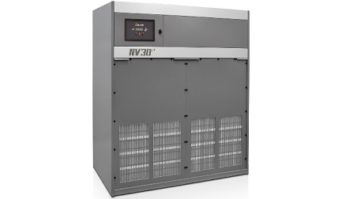Transmission precorrection
Aug 1, 2006 12:00 PM, By Doug Irwin
One of the great ironies in broadcast engineering is that we all grew accustomed to generating large of amounts of linearly modulated RF with amplifiers that were themselves very non-linear � whether it was a class-C vacuum tube amplifier in an FM transmitter, an AM transmitter full of switch-mode amplifiers or even the final amp in a high-level plate-modulated rig. Now that digital modulation has become so important, our amplifiers have to be linear.
Because digital modulation depends not only on the amplitude but also the phase of the modulated carrier, linearity in amplitude and phase response are vitally important in RF amplification of digitally modulated signals. After all, the receiver and demodulator need to be able to �understand� what is transmitted, so that the bit-error rate (BER) is low enough to provide good digital data out of the system. That can’t happen if the relative amplitude and phase of the transmitted signal are blurred by amplitude and phase distortions in the transmitter itself.
If the overall efficiency of the system were no issue, you could just run a class A amplifier having great linearity, but low efficiency. This is just not practical in most cases because the amount of RF typically needed would necessitate larger amplifiers, and thus larger power supplies, and thus a greater need for electricity. An effective compromise is a class AB amplifier � much better efficiency and linearity that is not that far off from that of a class A amplifier.

Click here to enlarge this image.
But even with better efficiency, we still need the ability to transmit a non-blurred signal–one that can be decoded with a low BER on the receiver end. When multiple carriers are transmitted at the same time–as in the case of HD Radio– then the non-linearities in the amplifier lead to spectral regrowth. Spectral regrowth is the generation of intermodulation products that effectively give the digitally modulated carrier much greater bandwidth than it would have if the amplifier were completely linear.
If you consider a digitally modulated RF signal that needs to propagate through a bandpass filter as part of a combiner, for example, then another set of complications can arise. Ibiquity specifies system gain flatness of �0.5dB with differential group delay of less than 600nS (�200kHz from the center frequency of the system). If the filter section is too narrow, or if it is tuned such that there is a gradient (time vs. frequency) in the time it takes for RF to pass through the filter, the digital modulation can be blurred and limit the BER at the receive end, and even cut back the effective coverage of the digital signal.
A technique called precorrection can be used in the RF amplifier to counteract the effects of a bandpass filter, or to minimize the effects of regrowth while maximizing the efficiency of the amplifier itself.
Put into action
For its digital transmitters, Nautel has developed a precorrection system called pre-equalization. The advantages the company points to in its methodology relate not only to the digital modulation, but also the analog modulation as well.
Let’s go back to the bandpass filter example. There are two characteristics of the analog signal that can be degraded by the filter section (or the tuning of the filter section) itself: the synchronous AM noise and the stereo separation. These can easily be measured. If you consider the hybrid signal � an analog FM carrier plus the digital carriers as one package � you must also consider the possible amplitude anomalies impressed upon the digital carriers as they propagate through the system. Nautel’s system works by building a digital finite impulse response (FIR) filter that has an equal and opposite characteristic to that of the bandpass filter. The analog modulating signal and the I&Q baseband are added together and run through this filter. After upconversion to the carrier frequency they are amplified up to the necessary RF level. The predistortion added by the FIR effectively cancels out that which is impressed upon the RF signal as it passes through the filter section.
Harris has its version, known as real-time adaptive correction (RTAC) that uses the technology that Harris developed for DTV transmitters. RTAC is used to simultaneously correct for linear (time and amplitude) distortions and nonlinear (AM-AM and AM-PM) distortions in the RF amplifier. The amplitude linearity distortion (AM-AM) becomes more pronounced near the amplifier’s saturation point; and so by minimizing its effects you can effectively increase the amplifiers output level and utilization (vs. a reference distortion amount). The phase linearity (AM-PM) distortion causes spectral regrowth; and so by minimizing both types of distortion, the hybrid signal from the amplifier can be made to fit the FCC’s spectral mask requirements.
RTAC can also be used to minimize “memory effects” that can be found in a vacuum-tube type amplifier (such as that caused by energy storage in the tuned circuits) and likewise in tuned filter sections, such as a bandpass filter. This memory effect causes the shape of the nonlinearities to continuously change with the data states being transmitted. RTAC adaptive precorrection continuously changes the shape of the precorrection curves from one data state to the next to correct memory effects.
Broadcast Electronics uses what it calls static DSP precorrection in its amplifier systems. The necessary precorrection to counter the effects of amplitude non-linearity, as well as phase non-linearity, are added to the system by way of DSP. Subsequent changes necessitated by changes in temperature or VSWR are also calculated ahead of time, and factored into the precorrection applied to the transmitter to optimize performance by the DSP. Memory-effects (such as the slew rate of a HV power supply in a vacuum tube transmitter) can also be effectively deleted by use of the same DSP.
Whether known as pre-equalization (in the case of Nautel), real-time adaptive precorrection (in the case of Harris), or static precorrection (in the case of BE), these design techniques provide greatly improved performance in terms of amplifier efficiency, spectral efficiency, efficacy of the IBOC transmission itself, and last but not least, the quality of the good old fashioned analog signal.
Irwin is director of engineering at Clear Channel, Seattle.










